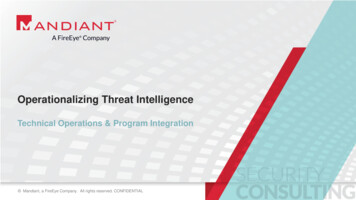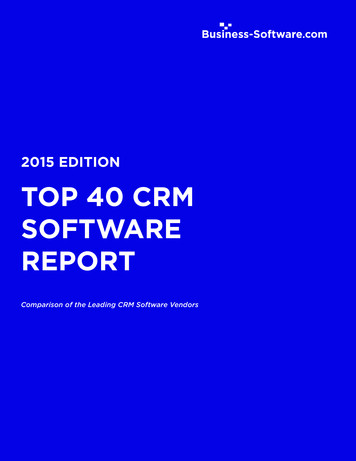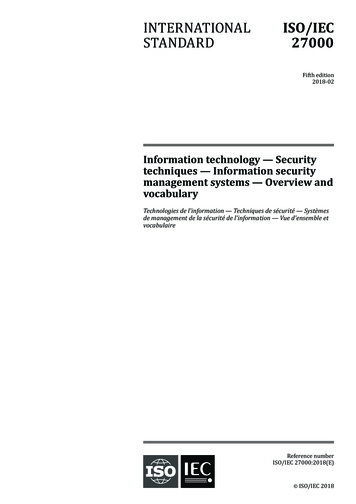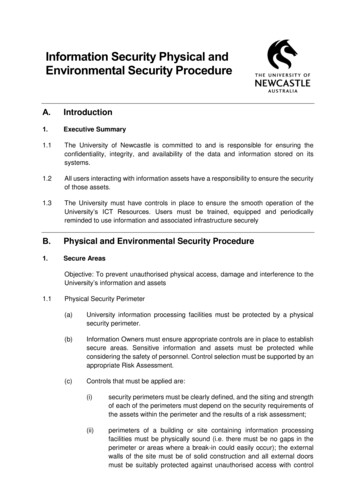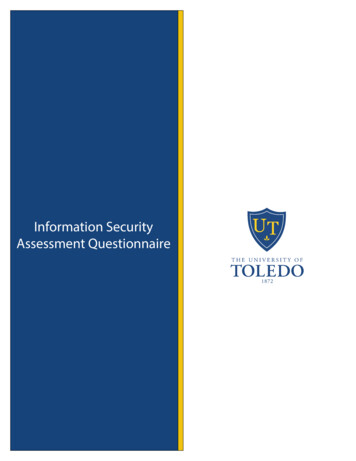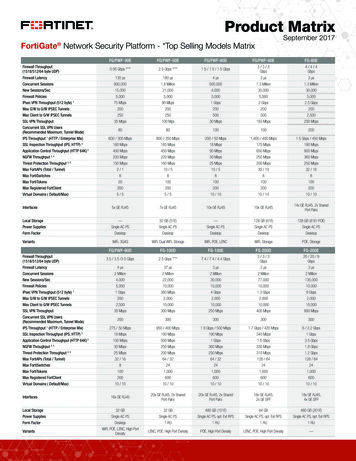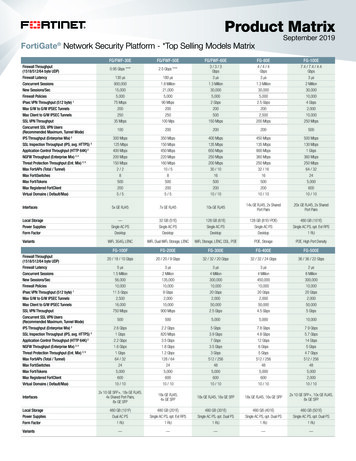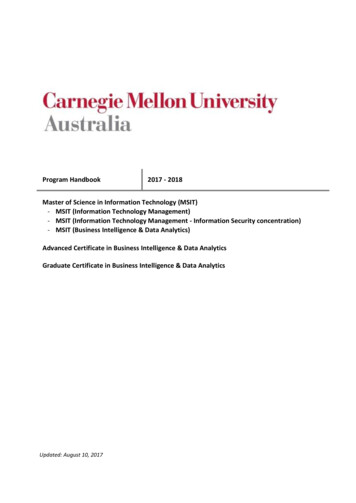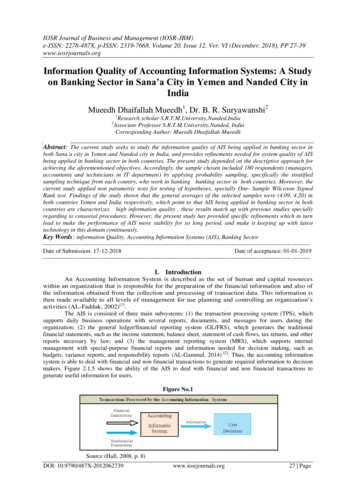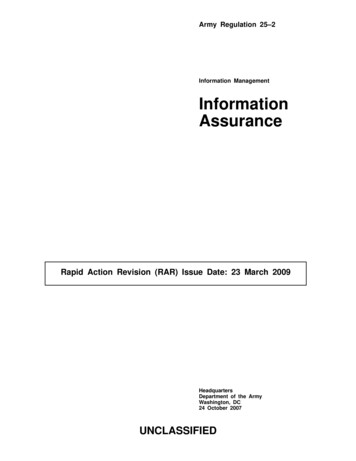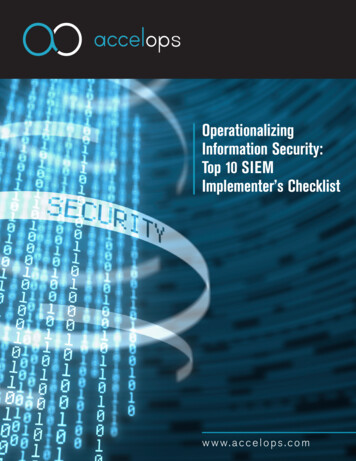
Transcription
OperationalizingInformation Security:Top 10 SIEMImplementer’s Checklistw w w. a c c e l o p s . c o m
Table of ContentsExecutive Summary . . . . . . . . . . . . . . . . . . . . . . . . . . . . . . . . . . . . . . . . . . . . . . . . . . . . . . . . . . . . . . . . . . . . 3SIEM Best Practice #1 – Malware control . . . . . . . . . . . . . . . . . . . . . . . . . . . . . . . . . . . . . . . . . . . . . . . . . . . . . . . . . 4SIEM Best Practice #2 – Boundary defenses . . . . . . . . . . . . . . . . . . . . . . . . . . . . . . . . . . . . . . . . . . . . . . . . . . . . . . . 5SIEM Best Practice #3 – Access controls . . . . . . . . . . . . . . . . . . . . . . . . . . . . . . . . . . . . . . . . . . . . . . . . . . . . . . . . . 7SIEM Best Practice #4 – Acceptable Use Monitoring . . . . . . . . . . . . . . . . . . . . . . . . . . . . . . . . . . . . . . . . . . . . . . . . . . . 9SIEM Best Practice #5 – Application defenses . . . . . . . . . . . . . . . . . . . . . . . . . . . . . . . . . . . . . . . . . . . . . . . . . . . . . . 11SIEM Best Practice #6 – Compliance and audit data requirements . . . . . . . . . . . . . . . . . . . . . . . . . . . . . . . . . . . . . . . . . . . 13SIEM Best Practice #7 – Monitoring and reporting requirements . . . . . . . . . . . . . . . . . . . . . . . . . . . . . . . . . . . . . . . . . . . 15SIEM Best Practice #8 – Deployment and infrastructure activation . . . . . . . . . . . . . . . . . . . . . . . . . . . . . . . . . . . . . . . . . . 17SIEM Best Practice #9 – Network and host defenses . . . . . . . . . . . . . . . . . . . . . . . . . . . . . . . . . . . . . . . . . . . . . . . . . . 19SIEM Best Practice #10 – Network and system resource integrity . . . . . . . . . . . . . . . . . . . . . . . . . . . . . . . . . . . . . . . . . . . 20AccelOps Security Information & Event Management (SIEM) . . . . . . . . . . . . . . . . . . . . . . . . . . . . . . . . . . . . . . . . . . . . . 22
Executive SummaryBest Practices e-bookThis e-book lists 10 Best Practices to provide you guidance for successful SIEM implementation and optimize your resources and accelerateyour return on investment. Whether you need to streamline incident response, automate audit and compliance processes, better managesecurity and business risks, or build out your deployed SIEM —this e-book presents process, metrics and technology considerations relative toSIEM implementation and security operations. Below are key takeaways for each of the 10 best practices in the e-book:SIEM Best Practice #1 – Malware controlCentralize malware monitoring, incident responses, assessing andreporting operational impacts from end point to perimeter withregard to ensuring activation and standard use, monitoring andreviewing malware activity, and most importantly, responding toissues. Make sure to include all sources including anti-malwareapplications, anti-virus, anti-trojan, spam filtering, web filtering andwebsite scanners, DNS, IDS, VA and network flow operational data.SIEM Best Practice #6 – Compliance and audit data requirementsUnderstand applicable industry, regulatory and legal obligations forsecurity and risk management. Compliance reports and dashboardsshould be refined to support security analysts, internal and externalauditors and the CIO or CSO. Be aware of any technical constraintsthat may impact performing investigations—without being able totrace back and analyze the necessary data, a firm’s liability, penaltyand notification exposure may be greater than actual.SIEM Best Practice #2 – Boundary defensesConsolidate monitoring of access activity from various boundarydefenses such as firewalls, routers, VPNs and other networkresources as well as cross-correlating network flows with otheroperational data to identify suspicious behavior and potentialsecurity threats. Understand boundary definitions in eachorganization in terms of levels of risk, appropriate access grantsand monitoring interests. Pay attention to dynamic virtualizationmovements that make moving boundary targets harder to monitor.SIEM Best Practice #7 – Monitoring and reporting requirementsEstablish key monitoring and reporting requirements includingobjectives, targets, capacity requirements, compliance reports,implementation and workflow with key constituents prior todeployment of any technical tools. It is important to take a phasedapproach to achieve success – an “All At Once” approach willusually falter due to the human factors involving organizational (andindividual) education, changing requirements and accountability.SIEM Best Practice #3 – Access controlsConsolidate Authentication, Authorization and Accounting (AAA)mechanisms to control appropriate access to resources. Use SIEMrules, alerts and reports to bring together all AAA – successfullogins, subsequent secondary logins and user/system activitiesto facilitate investigations. Track and resolve the “true identity”behind shared credentials. Make sure to put incident response andreport review procedures in place prior to activating SIEM rulesand reports. Monitor failures in addition to successful accesses tomonitor and investigate insider threats including privileged usersand consultants.SIEM Best Practice #4 – Acceptable Use Monitoring (AUP)Publish policies for users to understand when, where and how bestto use and protect corporate assets and information. Develop watchlists to facilitate monitoring processes for AUP for critical resources,user roles and specific AUP violation scenarios that align to thosepolicies. Extend activity monitoring beyond normal businesshours with special focus on critical assets or anomalous behavior.Obtain appropriate legal advice to assure that potential liabilityfor monitoring user activity is understood and addressed. By nothaving accurate records with regards to the scope of an incident, theresulting financial penalties and reputation risks can be significant.SIEM Best Practice #8 – Deployment and infrastructure activationManage the deployment in phases, maintain source activation andconsistent delivery of event and log data and refine the systemcontinuously. On-going maintenance costs and growth plans needto be incorporated as part of the overall planning to obtain a trueTotal Cost of Ownership (TCO). Lack of documented procedures toensure appropriate activation and access to event log data will leadto monitoring and audit gaps.SIEM Best Practice #9 – Network and host defensesAggregate IDS/IPS alerting, conduct event consolidation onlike alerts, filter IDS/IPS false positives and facilitate incidentmanagement. Integrate incident management / case managementtools and generate test traffic to test SIEM integration with IDS andincident response processes. It is important to detect false positivealerts such as the detection of benign attacks or malicious activitiesby an IDS/IPS that otherwise require security staff to respond.SIEM Best Practice #10 – Network and system resource integrityUnderstanding the infrastructure, from deployed devices, systems,applications to configuration, vulnerability and patch details isrequired to assure and maintain operating integrity. For resourceintegrity, it is necessary to understand the complete context ofwho, what, when, why and where information with regards to anapproved, unauthorized or undocumented change.SIEM Best Practice #5 – Application defensesApplication defenses is required beyond the perimeter, networkand host security defenses need to include application platformmonitoring, resource monitoring, web application defenses anddatabase activity monitoring. Incorporate web application firewalls(WAF) to inspect and filter HTTP traffic at the application layer tomonitor web and mobile applications. Database logging can beproblematic with regards to database performance and databaseaudit table overwrites. The use of shared administrative credentialsis another pitfall to watch for.3
1Malware controlSubject CoverageMonitor and report on key status, threats, issues, violations andTracking of virus, malware, spyware,activity supporting malware controls.spam, malicious website request,Overview and Highlight ProcessesOne of the more popular end point security tools is anti- virus. However, malware controlis not limited to the use of anti- virus tools, but extends to managing additional threats,unusual resource activity, as well asdetection, quarantine and remediation.RecommendedSample Metricsinfections, scope of infection, outages and breaches related to a variety of malware risks and Top reported malware threatsactivity. Malware controls would comprise of identifying, mitigating and measuring: viruses, Anti- virus trends; prevented, detected,root kits, trojans and spyware issues, botnet, peer- 2- peer activity, spam, and suspiciouswebsite and email communications.The majority of information security compliance frameworks specify employing anti- malwaretools. Best practices dictate that anti- malware implementation should be tiered from endpoint to perimeter (e.g. client, server and gateway). Processes should be established withremediated Spam trends; identified and removed Top malware attacked sources, and byprior vulnerability issuesregard to ensuring activation and standard use, monitoring and reviewing malware activity, Top unusual traffic to and from sourcesand most importantly, responding to issues. This would include monitoring various anti- Top source and destinations of maliciousmalware solutions for updates and failures. Procedures with regards to malware includemanagement, incident response, infection or breach documentation, issue notification,quarantine of infected systems, and remediation.Organizations should routinely monitor for critical anti- virus/malware issues; prioritized bysystem, type of issue, effect on operations, or the scope/probable spread of infection. SIEMsoffer the means to centralize malware monitoring and reporting processing, measuringon overall malware infection, and assessing operational impact. One method to facilitateconnections Top systems with multiple infections / topsystems re- infected Top systems with suspicious malwareactivity Anomalous network activitymonitoring is to correlate event log data from anti- malware management systems rather than Atypical email or web communicationsend point devices themselves. Keeping track of resolved infections or problems also helps Anti- virus stop, start, update failuresjustify security expenditures. For example, SIEMs can report spam and viruses prevented ormitigated at the MTA gateway.SIEMs also provide the means to centralize malware incident response. One usefulmonitoring practice is to enable SIEMs to allow operators to focus on detection- only (ratherthan remediated) malware issues, as well as identifying difficult malware threats. SomeSIEMs have the means to assimilate network flow data and establish baselines or profiles oftraffic activity. Having this broader context allows the SIEM to identify suspicious applicationactivity and network traffic bursts, such as identifying symptoms and direct activity relatedTechnology Considerations Sources will include all anti- malwareapplications; anti- virus, anti- trojan,spam filtering, web filtering and websitescanners For greater SIEM context, additionalto botnets and worms. SIEMS can also facilitate processes to identify infected systemssources include DNS, IDS, VA andto quarantine and remediate, by correlating: unusual DNS requests, unusual port activitynetwork flow operational datafrom the firewall log, unusual traffic spikes via network flow data, identified port scanningand outbound traffic attributed to zombies, or warnings from the IDS/IPS on outbound Leveraging the anti- malware manager,versus clients, as reporting sourcescommunications to a known malicious site.4
2Boundary defensesSubject CoverageMonitor and report on key status, configuration changes, violations/Firewall, NAC, NAT, VPN, routers,attacks and anomalous activity associated with perimeter defenses.proxy systems, wireless Access PointOverview and Highlight ProcessesBoundary defenses, also known as perimeter countermeasures, such as firewalls, routers,VPNs and other means of network- based access controls, remain vital to defend againstunauthorized access to network resources, as well as to prevent threats and attacks. WhileDMZs (demilitarized zone) serve as a checkpoint between the public network and company’sprivate network, perimeter defenses in general serve to grant or prevent internal usersor systems from accessing network resources within and outside the corporate network.(WAP), attacks and violations, ports,anomalous request types, denial ofservice and false positives.RecommendedSample Metrics Top access failures by source anddestinations Top inbound connections to internalFirewalls, and variations thereof, filter acceptable inbound and outbound connections,sources by system, user, bandwidth andin terms of allowing or denying communications based on rules referencing computers,timeapplications, services, ports or protocols. Top outbound connections to externalThere are multiple boundaries or perimeters in an organization. There are perimeterssources by system, user, bandwidth andbetween users and systems; remote users and internal resources; business partners andtimeextranets; and wireless access points and the corporate network. Top outbound DMZ connections toA level of understanding is necessary with regards to defining boundaries in terms ofexternal sources by system, user,levels of risk, appropriate access grants, and monitoring interests. Once discrete perimeterbandwidth and timecontrols have been configured and policies defined, whether comprised of firewall policies, Top perimeter attacks by categoryrouter, VPN and RADIUS ACLs (Access Control Lists), wireless access points, as well as other Top dropped traffic from DMZ, FWforms of perimeter defenses, the respective logs and notifications from the devices mustbe activated and verified. SIEMs can serve as a centralized point to capture boundary state,changes and issues.Some network devices, such as firewalls, can provide network flow information. Networkflow is a record of network packet flow information, which contains details such as source Top blocked internal sources by port, bydestinations Top blocked outbound connections byport, by destinationand destination address, port (application) and amount of data. This type of information can Unusual DNS access and requestsbe vital for incident response or monitoring for advanced persistent threats (APT). Changes to active and standbyNetwork flow is produced by popular network firewalls, switches and routers, whichdisseminate the data according to vendor- specific protocols such as Cisco Netflow.Some SIEMS can process, analyze and manage network flow and use this information tounderstand network resource utilization. SIEMs can cross- correlate network flow with otheroperational data to identify suspicious behavior and potential security threats.Virtualization presents additional potential challenges with regards to boundary defenses.The automated resource and network access provisioning and potential for dynamic VMmovement (as described further in regards to network and system integrity), does present therisk of a VM and respective guest host to leave one boundary and go into another. Attentionshould be paid to alleviate this condition by way of proper virtualization configurationmanagement.configurations by perimeter device class Daily or weekly alerts on top 10connections from sites of concerns Top unusual peak bandwidth utilizationsources and destination Top bandwidth by protocol, byconnection, by source, by destination Configuration changes FW, VPN, WAP,Domain Failure FW, VPN, WAP, Domain Multiple login failures by FW, VPN,Domain Excessive VM movement by VM, by guesthost Non- compliance VM movement by VM,by guest host Wireless network access by location, byuser, by failed attempts5
Technology ConsiderationsSIEMs can be used to consolidate the monitoring of access activity from various boundary Sources will include firewall, router,be monitored by business and operational risk, as well as assess frequency and type ofdefenses. It is suggested that organizations compile a prioritized list of key attributes towireless AP, VPN, RADIUS, proxy systems,required monitoring; be it daily, weekly, monthly, real- time correlation or historic report.other authentication systems, NAC, NAT,Daily operational procedures should cover incident response, as well as incident and reportand host OS logs.reviews. Case management can track who and how specific incidents were investigated and Most SIEMs have rule and report setsresolved.to monitor perimeter defenses, butnot necessarily configuration changes,network flow nor statistical profilingto detect anomalous network andapplication activity. This can impactcompliance monitoring and can requireaccess to other types of IT managementsystems. Adjusting correlation rule severity bysource IP, destination IP, user or assetgrouping can help support prioritizingincident response and compliancemandates6
3Access controlsSubject CoverageMonitor and report on key status, violations and anomalous access toAAA servers, VPN/RAS/NAS, Directorycritical resources.Services, privileged and administrativeOverview and Highlight ProcessesMonitoring resource access is critical to preserve system integrity and availability, as well asaccess, excessive failures, terminatedaccount use, service account use,tracking 3rd party and consultantaccess, and monitoring accessadministration.protect information assets, financial information, personal identifiable information (PII), andsensitive and proprietary business information. The creation of policies and procedures tomanage and monitor user, and service account, resource access is also a requirement that isuniversal among numerous compliance mandates and IT management frameworks.Authentication, authorization and accounting (AAA) mechanisms to control appropriateaccess to resources. Authentication identifies the user based on requesting unique attributes/factors prior to access such as user name, password and token. Authorization associatesresource rights/privileges to the user or class of users based on the type of functions of theresource being accessed. Accounting, for this documents purpose, is the enablement and useof audit logs.Many organizations leverage directory services to facilitate the management of and accessto resources by defining and maintaining user, system and group objects, and associatingRecommendedSample Metrics Top access failures by source, destination,user, business unit Access failure by prioritized logicalgrouping (e.g. payment processingresources) Top access destinations by users/groupsand anomalous access Access login success and failurerights to said objects. Virtual Private Networks, Remote Access Servers and Network Access(internal); by user, system, by deviceServers, among other network access mechanisms, can then reference user, system andclass, by time (with details)group object attributes maintained within a directory service.SIEM can monitor directory services in terms of creating and modifying defined users,groups and respective resources
Top 10 SIEM Implementer’s Checklist. Table of Contents . AccelOps Security Information & Event Management (SIEM). . to monitoring and audit gaps. SIEM Best Practice #9 – Network and host defenses Aggregate IDS/IPS alerting, conduct event consolidation on like alerts, filter IDS/IPS false positives and facilitate incident .
